Yves GARY Hits: 1571
Category: 1871 : CHALLENGE N°2
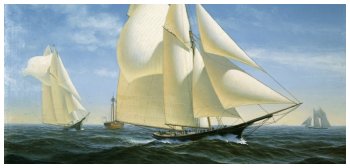 The American Yacht Columbia Victorious
The American Yacht Columbia VictoriousCopyright © The New York Times : Published: October 17, 1871
After the long and apparently endless correspondence, it is a pleasant task to chronicle the details of the first of the series of matches for possession of the America Cup.
The contestants agreed to sail a series of seven races, four out of seven to win. Three of these were to be sailed over the regular regatta course, three outside Sandy Hook Light-ship, and, in case of a tie, the seventh race will also be sailed outside the Hook Light-ship.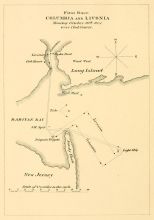 The race over the New-York Yacht Club course was from an anchorage west of a flag-boat stationed near the Quarantine Landing, Staten Island, to the Red First-class Can Buoy west on South-west Spit Buoy, designated on the char map as Buoy No. 10, passing it to the west and south; thence to the Light-ship, rounding it to the‘ northward and westward, returning over the same course, passing to the cast, going and returning, of all the buoys on the West Bank—viz., Nos. 13. 11 and 9— and to the westward of the flag-boat stationed near the Quarantine Landing.
The steamer William Fletcher, with the Committee and members of the Press on board, left the foot or Desbrosses-street at 9 A. M. yesterday. The fletcher arrived at Quarantine landing about 9:40, and found the Livonia, Sappho and Columbia lying in readiness to start. The Committee were not long in deciding which boat was to represent America on this eventful day, and steaming up alongside of the Columbia, Mr. MINTON hailed Rear-Commodore OSGOOD and briefly announced the honor in store for him. While the two yachts were getting up their canvas, a number of steamers arrived, laden with excursionists to see the race. The steamers included the Magenta, D.R. Marlin, Americus, Olive Baker, Sea Bird. Andrew Fletcher, Antelope. Arrowsmith, and others. The yachts Magic, Tarolinta, Madeleine, Tidal Wave, Fleur de Lis, and Coquette were also lying around.
The race over the New-York Yacht Club course was from an anchorage west of a flag-boat stationed near the Quarantine Landing, Staten Island, to the Red First-class Can Buoy west on South-west Spit Buoy, designated on the char map as Buoy No. 10, passing it to the west and south; thence to the Light-ship, rounding it to the‘ northward and westward, returning over the same course, passing to the cast, going and returning, of all the buoys on the West Bank—viz., Nos. 13. 11 and 9— and to the westward of the flag-boat stationed near the Quarantine Landing.
The steamer William Fletcher, with the Committee and members of the Press on board, left the foot or Desbrosses-street at 9 A. M. yesterday. The fletcher arrived at Quarantine landing about 9:40, and found the Livonia, Sappho and Columbia lying in readiness to start. The Committee were not long in deciding which boat was to represent America on this eventful day, and steaming up alongside of the Columbia, Mr. MINTON hailed Rear-Commodore OSGOOD and briefly announced the honor in store for him. While the two yachts were getting up their canvas, a number of steamers arrived, laden with excursionists to see the race. The steamers included the Magenta, D.R. Marlin, Americus, Olive Baker, Sea Bird. Andrew Fletcher, Antelope. Arrowsmith, and others. The yachts Magic, Tarolinta, Madeleine, Tidal Wave, Fleur de Lis, and Coquette were also lying around.
The Columbia soon got up her mainsail, foresail, and gaff topsails, and in a few minutes the Livonia was likewise equipped and ready for the start. The following gentlemen were the guests or Rear-Commodore OSGOOD on board the Columbia: Commodore J AMES GORDON BENNETT, JR., Mr. HENRY HARLET, Mr. GEORGE W. WILSON, Mr. LESTER WALLACE and Captain COFFIN. Lord WALTER CAMPBELL, accompanied Commodore ASHBURY in the race. The sloop Anna was anchored off Quarantine as the stake-boat, in charge of Mr. DORLON of Fulton Market. The wind at this time was about northwest, with a shade more northing, and the tide at the first of the ebb.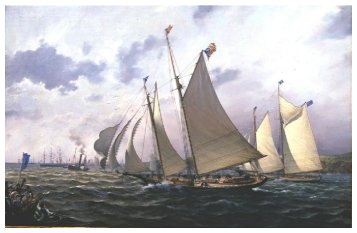 At 10:35 the flag was hauled down off the William Fletcher, the Committee steamer, and both yachts prepared to get under way. The Livonia had set two large square topsails, thoroughly characteristic of her nationality. Both vessels lay with their bows pointed to the Quarantine Landing, and all canvas set, with the exception of the jibs. They are rather similar in appearance, and both painted black with a gold line round the deck line. At 10:40 up went the flag on the Committee boat, and a long shrill whistle gave the starting signal. The Columbia ran up her three jibs simultaneously in a very smart style, and was under way before the Livonia, who, however, tried to be smart by running up her jib clewed up, shaking it out when up. It was the difference in model, however, that really gave the Columbia such a good start, as her small draft makes her very quick to move, while the deep English keel-boat required considerably more wind to get her under way. The wind by this time had died away considerably, and there was only enough to keep all canvas well filled. The Columbia had set main foresail, main foretopsail, three jibs and staysail. The Livonia had the same canvas up. Off the third landing, the Livonia boomed out her jib to try and catch a little or the breeze which was now dead aft. She was evidently too near shore, and the Columbia was rapidly slipping away with this light breeze. The Tidal Wave came up the middle channel with a party of guests on board, and having a good breeze, passed quietly ahead or the Columbia, who at this time was covered by Fort Richmond. As soon, however, as that point was passed, her big balloon jib came into use, as she caught the breeze and all her canvas filling as she luffed up a little, the chances of the Livonia appeared to grow smaller and more beautifully less.
At 10:35 the flag was hauled down off the William Fletcher, the Committee steamer, and both yachts prepared to get under way. The Livonia had set two large square topsails, thoroughly characteristic of her nationality. Both vessels lay with their bows pointed to the Quarantine Landing, and all canvas set, with the exception of the jibs. They are rather similar in appearance, and both painted black with a gold line round the deck line. At 10:40 up went the flag on the Committee boat, and a long shrill whistle gave the starting signal. The Columbia ran up her three jibs simultaneously in a very smart style, and was under way before the Livonia, who, however, tried to be smart by running up her jib clewed up, shaking it out when up. It was the difference in model, however, that really gave the Columbia such a good start, as her small draft makes her very quick to move, while the deep English keel-boat required considerably more wind to get her under way. The wind by this time had died away considerably, and there was only enough to keep all canvas well filled. The Columbia had set main foresail, main foretopsail, three jibs and staysail. The Livonia had the same canvas up. Off the third landing, the Livonia boomed out her jib to try and catch a little or the breeze which was now dead aft. She was evidently too near shore, and the Columbia was rapidly slipping away with this light breeze. The Tidal Wave came up the middle channel with a party of guests on board, and having a good breeze, passed quietly ahead or the Columbia, who at this time was covered by Fort Richmond. As soon, however, as that point was passed, her big balloon jib came into use, as she caught the breeze and all her canvas filling as she luffed up a little, the chances of the Livonia appeared to grow smaller and more beautifully less. 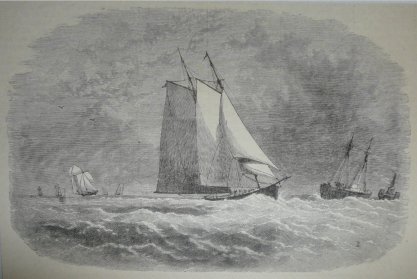 Both yachts were given plenty of room thus far, the excursion steamers keeping at a respectful distance, and allowing them a fair chance. By the time the Livonia had rounded Fort Richmond, the Columbia was fully five minutes ahead, and rapidly increasing her lead. The decided advantage that the Columbia had already gained tended considerably to lessen the interest in the race, and it appeared very much, as Mr. STEERS, quietly pronounced it, “a very soft thing.” Passing Quarantine Hospital, the Columbia was slipping through the water very nicely, with the Tidal Wave hanging on her leeward quarter, a position, however, which she did not retain long, but dropped quietly astern. The wind appeared to be getting very shifty, and off the hospital-ship the Columbia was nearly becalmed, and her balloon jib hung idly by the mast. There was not much more than four minutes difference between the two yachts, and the Livonia appeared to be improving her position, although the gain was only just perceptible.
Both yachts were given plenty of room thus far, the excursion steamers keeping at a respectful distance, and allowing them a fair chance. By the time the Livonia had rounded Fort Richmond, the Columbia was fully five minutes ahead, and rapidly increasing her lead. The decided advantage that the Columbia had already gained tended considerably to lessen the interest in the race, and it appeared very much, as Mr. STEERS, quietly pronounced it, “a very soft thing.” Passing Quarantine Hospital, the Columbia was slipping through the water very nicely, with the Tidal Wave hanging on her leeward quarter, a position, however, which she did not retain long, but dropped quietly astern. The wind appeared to be getting very shifty, and off the hospital-ship the Columbia was nearly becalmed, and her balloon jib hung idly by the mast. There was not much more than four minutes difference between the two yachts, and the Livonia appeared to be improving her position, although the gain was only just perceptible.
Passing the Red Can Buoy on the main channel, the Columbia still had a clear lead of a third of a mile and had just enough wind to keep all canvas full. The Livonia did not appear to be doing quite so welt and was certainly not gaining on the Columbia. As the Columbia came up toward the buoy, on the south-west Spit, the steamers all came up in that direction to give their passengers a chance of viewing the turn round Buoy No. 10. As the Columbia came up she lowered her foretopsail, and rounding, jibed her main boom and took down her staysail. They were very lively on board, and soon got the topsail and staysail set and drawing, and the Columbia started off lively in the direction of the point of the Hook. The Livonia came up about four minutes and a half later. On board the Livonia, as they jibed, they clewed up the foretopsail and lowered the staysail, and were a little quicker in getting them set and drawing, but they were considerably bothered with their big balloon jib, which was rigged to the end or the jib-boom, and proved a rather unwieldy sail.
The yachts rounded as follows :

The Madeleine was sailing very well, and beat the Englishman about half a minute up to the South-west Spit. The wind new appeared to be dying away, and by the time the committee boat came up to the Columbia, 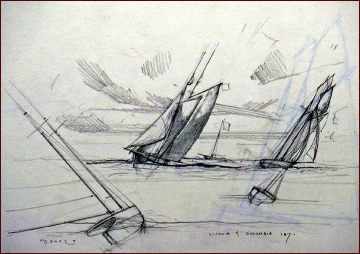 her forward sails were hanging idly from the stays. The wind, what little there was left, was still about north-west by north. Off Sandy Hook the Columbia was still about the same distance ahead, but barely moving through the water, while the Livonia, about one-third or a mile astern, appeared to have enough breeze to keep her canvas full, and had her jib run out to windward, with the evident intention of making good use of all she could catch. The accompanying fleet were all scattered around, beating off in every direction. A few minutes before 1, the Columbia appeared to catch a little puff which, though very slight, was sufficient to fill her canvas, and give her a little more headway. The Livonia appeared to be holding her own, but it was very apparent taut unless the breeze increased considerably she did not have the slightest chance or coming one successful. As the yachts got out into a little more open water, the breeze appeared to freshen up a little, and the contesting yachts danced over the water with a little more life. The wind, however, was nearly dead aft, so that the mainsail was nearly the only drawing sail. The Columbia appeared to be gaining steadily on the Livonia, and increasing her lead every minute.
her forward sails were hanging idly from the stays. The wind, what little there was left, was still about north-west by north. Off Sandy Hook the Columbia was still about the same distance ahead, but barely moving through the water, while the Livonia, about one-third or a mile astern, appeared to have enough breeze to keep her canvas full, and had her jib run out to windward, with the evident intention of making good use of all she could catch. The accompanying fleet were all scattered around, beating off in every direction. A few minutes before 1, the Columbia appeared to catch a little puff which, though very slight, was sufficient to fill her canvas, and give her a little more headway. The Livonia appeared to be holding her own, but it was very apparent taut unless the breeze increased considerably she did not have the slightest chance or coming one successful. As the yachts got out into a little more open water, the breeze appeared to freshen up a little, and the contesting yachts danced over the water with a little more life. The wind, however, was nearly dead aft, so that the mainsail was nearly the only drawing sail. The Columbia appeared to be gaining steadily on the Livonia, and increasing her lead every minute.
Coming up toward the light-ship the breeze kept improving, and the yachts were setting a little faster through the water. About 300 yards from the light-ship the Columbia jibed her boom over, and coming up steadily, hauled close up as she went around, and was soon skimming along on her homeward journey. The contest at this time cullvened by a little heavy artillery from the Fletcher, furnished at the expense of the Quarantine Commission. The Livonia came up very slowly, and jibed over about 400 yards from the light-ship. She had lost nearly ten minutes on the run from the South-west Spit.
The two yachts rounded as follows:

Homeward bound the Columbia appeared to be gilled with invisible wedge, and was getting further and to further ahead every minute. In fact, it became more and more apparent that the English yacht had no chance with the American. The wind was still very light, and could hardly be called more than a five-knot breeze. The Columbia by this time was nearly two miles ahead, and kept steadily increasing her lead. The Columbia still held on the starboard tack, heading up toward the Highland Light. The Livonia did not appear to be holding quite so good a wind, and still kept her small staysail set. The Columbia kept on the starboard tack until within about three miles of the shore, when she went about and went off on the port tack, running parallel to the coast in the direction of Sandy Hook. There was barely a ripple on the water now. The Livonia, after standing on within four miles of shore, took in her staysail and went about at 2:17. Now that both boats were lying on the port tack, with the Committee boat leading, it became apparent that with this little breeze the Livonia could not sail within half a point as close to the wind as the Columbia. As the latter came alone she evidently widened the distance between her and the English representative.
The Columbia, after continuing on the port tack for some time, went about at 3:15, and stood in for Sandy Hook. The Livonia did not tack until 3:24 and then, after a short stretch in-shore, went about again at 3:34 on the port tack. The wind had now nearly died away, but there was still sufficient to keep the canvas full. The Columbia held steadily along on the starboard tack and weathered the $andy Hook Point Buoy, cleverly and holding on about a quarter of a mile further, went about and stood on the port tack for the south-west Spit at 3:36:30. The way in which the Columbia was handled is especially worthy of mention, and America could not have a worthier representative vessel in whom to trust her honor. 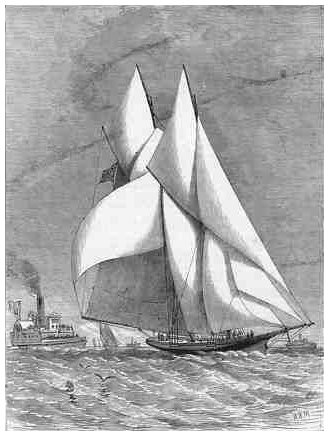 Rear-Commodore FRANKLIN OSGOOD is an indefatigable worker on board his yacht, and, combined with COMSTOCK, his Captain, it would be hard to find a better team to handle a fore and aft vessel. The Livonia went about again at 3:45:30, and. standing in on the starboard back weathered the Sandy Hook Buoy, but she was now hopelessly beaten. The breeze now began to freshen up considerably, and the Columbia came flying along toward the South-west Spit at a lively rate, leaving her opponent tar away behind. As the Columbia came up close to the buoy, it was pleasant to watch the discipline on board, one man at the main-sheet, one at each of the jib-sheets, and a dozen at the staysail. The Rear-Commodore was all alive, and, heedless of the cheers with which his boat was saluted, attended to business, and have his orders relative to the staysail. She presented a beautiful picture as she paid off on the road home, a couple of points off the wind and every sheet started, heeling over with the increased force of wind now brought to bear, and flying through the water at about twelve knots an hour. The last chance of the Livonia was crushed when the breeze sprung up, as up to that time there was a possibility of neither boat making the race within the required limit of eight hours. The Livonia racked again tor the South-west Spit at 3:52, and, catching the breeze, improved her speed, but still was losing ground.
Rear-Commodore FRANKLIN OSGOOD is an indefatigable worker on board his yacht, and, combined with COMSTOCK, his Captain, it would be hard to find a better team to handle a fore and aft vessel. The Livonia went about again at 3:45:30, and. standing in on the starboard back weathered the Sandy Hook Buoy, but she was now hopelessly beaten. The breeze now began to freshen up considerably, and the Columbia came flying along toward the South-west Spit at a lively rate, leaving her opponent tar away behind. As the Columbia came up close to the buoy, it was pleasant to watch the discipline on board, one man at the main-sheet, one at each of the jib-sheets, and a dozen at the staysail. The Rear-Commodore was all alive, and, heedless of the cheers with which his boat was saluted, attended to business, and have his orders relative to the staysail. She presented a beautiful picture as she paid off on the road home, a couple of points off the wind and every sheet started, heeling over with the increased force of wind now brought to bear, and flying through the water at about twelve knots an hour. The last chance of the Livonia was crushed when the breeze sprung up, as up to that time there was a possibility of neither boat making the race within the required limit of eight hours. The Livonia racked again tor the South-west Spit at 3:52, and, catching the breeze, improved her speed, but still was losing ground.
Both yachts rounded the South-west Spit as follows :

As the yachts approached the Lower Bay the scene became more lively, and numbers of small craft came out to meet the yachts on their road home. The Committee boat had to get up all steam to try and keep up with the Columbia, but in this instance wind was more powerful than steam, and the swift American yacht beat the power of steam. The Narrows presented a very pleasing spectacle, the waters all dotted over with small craft, anxiously looking out for the first boat, and when they round the American colors ahead, they sent up a cheer of welcome that must have gone home to the bottom of the hearts or the Columbia’s crew. A stern chase is always a long one, and in this instance the Livonia must have found it especially so, as, instead of gaining, she was losing ground every minute. The Columbia kept her lead steadily, and moved gracefully through the fleet of vessels that were now congregated off Quarantine Landing. No boat was ever before greeted with such an enthusiastic reception, and as she passed the stake-boat the din was perfectly terrific. The Livonia did not arrive until a full half hour later, but received a warm welcome. As soon as the bows had arrived the steamers and spectator yachts all started off for home.
The following is the official time :

which makes the Columbia the winner first of the series of races by 27 minutes and 4 seconds.

THE INTERNATIONAL YACHT RACES - Hunt's Yachting Magazine Dec. 1871 - Google Livres
THE QUEEN'S CUP. - First Race of the Series in the International Yachting Contest.The American Yacht Columbia Victorious--TheLivonia Half an Hour Behind--Scenes and Incidents. - Article - NYTimes.com:
